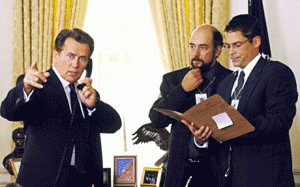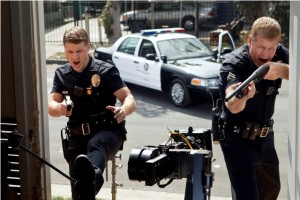By Christina Kallas
 One thing’s for sure: people don’t go to writing to be rewritten. But they still are, first and foremost by the showrunner. The showrunner is the writer who tells the writers what to do, and who will eventually do it herself.
One thing’s for sure: people don’t go to writing to be rewritten. But they still are, first and foremost by the showrunner. The showrunner is the writer who tells the writers what to do, and who will eventually do it herself.
So should a showrunner polish the final draft of every episode to preserve the “voice” of the series, or should each individual writer be allowed to use their voice to bring out new sides to the characters and the series? The conventional wisdom seems to come directly from auteur theory and wants everything to be from one mold, carrying a single signature and voice – so as to pretend that one person wrote it.
I was most intrigued by something Jenny Bicks said when we had our conversation for my book. She talked about using different writers in Sex and the City. She explained how she will not rewrite physically but rather give notes to the writer as opposed to polishing the writer’s draft herself. But then again, Jenny believes that a show works best if there is more than a singular voice, and if a different aspect of each character gets represented by each writer: “If you watch Sex and the City, you’ll notice that each episode feels maybe a little different. I know which writer wrote it, because it is perhaps a bit more cynical, more of a cynical side of Miranda, more this kind of Carrie, and in the end it’s the different characters but it’s not one voice. It’s one voice with different angles.”
Most of the writers suggest that each writer gets a shot at two drafts before the showrunner comes in for a polish or sometimes a rewrite. Terence Winter talks about how he would hope that the writer at least gets him 50% there – a draft, which is halfway to where he needs it to be. And how ideally it would be 95%. When they miss the mark so completely that he needs to rewrite it from the first page, then it’s usually an indication that it is not gonna work.
 But what does it mean for a writer to be writing in the show’s voice, and so ultimately in someone else’s voice? When we discussed this, Diana Son, who has also written for Blue Bloods, Southland and The West Wing, used the example of Law & Order, which she was writing for some time, and talks about how she would write a line and she would think that the showrunner was going to love it: “It sounds like a line he would write. And then, I’m in another scene, and I think, Oh my God, I am so tempted to write this line and I know that René will hate it, but to amuse myself I’m just gonna put it in. And then, after René rewrote me, I would find out that he rewrote the line I thought sounded just like him and he kept the line that was so me that I thought he wasn’t going to like it.”
But what does it mean for a writer to be writing in the show’s voice, and so ultimately in someone else’s voice? When we discussed this, Diana Son, who has also written for Blue Bloods, Southland and The West Wing, used the example of Law & Order, which she was writing for some time, and talks about how she would write a line and she would think that the showrunner was going to love it: “It sounds like a line he would write. And then, I’m in another scene, and I think, Oh my God, I am so tempted to write this line and I know that René will hate it, but to amuse myself I’m just gonna put it in. And then, after René rewrote me, I would find out that he rewrote the line I thought sounded just like him and he kept the line that was so me that I thought he wasn’t going to like it.”
So perhaps it is not about trying to write in the showrunner’s voice? Perhaps it is more than that? As Tom Fontana says in our conversation, as a showrunner he does not want to be handed back scenes which he could have written himself. After all, collaborative writing means that each one contributes what they are best at and what they are needed for: their individualism, their very own truth. Still, a writer is taking a risk every time she goes off track, and it may very well go wrong. Then, let it go wrong. At least three of the writers I talked with stressed after all a single piece of advice and I could not agree more: stay true to yourself.
Next Up: Post #7: How To Rewrite and Be Rewritten, Part II
If you are interested in reading more, including the full interviews on their process as writers with creators such as Terence Winter, Tom Fontana, Warren Leight, Robert Carlock, Janet Leahy and many more, you can purchase the book Inside the Writers’ Room. Conversations with American Writers here.
 Christina Kallas has written and produced several feature films and TV shows in Europe before she relocated to New York in 2011, where she is currently teaching at Columbia University’s and Barnard College’s Film Programs, and editing her next feature film (and her first as a director,) 42 Seconds of Happiness. She is the author of six books in her three writing languages, including the above book as well as Creative Screenwriting: Understanding Emotional Structure (London/New York, 2010). Most recently, she was honored for her outstanding contribution to the international writers’ community in her eight years of tenure as President of the Federation of Screenwriters in Europe. You can reach her at improv4writers@gmail.com and follow her on Facebook or Twitter and join the Writers Improv Studio group page for updates.
Christina Kallas has written and produced several feature films and TV shows in Europe before she relocated to New York in 2011, where she is currently teaching at Columbia University’s and Barnard College’s Film Programs, and editing her next feature film (and her first as a director,) 42 Seconds of Happiness. She is the author of six books in her three writing languages, including the above book as well as Creative Screenwriting: Understanding Emotional Structure (London/New York, 2010). Most recently, she was honored for her outstanding contribution to the international writers’ community in her eight years of tenure as President of the Federation of Screenwriters in Europe. You can reach her at improv4writers@gmail.com and follow her on Facebook or Twitter and join the Writers Improv Studio group page for updates.





